Reader, I have to admit: it has been several days since I first saw the Star Trek: Picard season two finale by the time you’re reading this. And I still cannot tell you if I mean to say “unhinged” here as either a good or a bad thing.

“Farewell” is, of course, an episode of goodbyes — farewell to the series’ time travel plotline, farewell to some pretty major characters, farewell to many ideas about how an episode of television should have paltry elements like “coherence between scenes” and “a plot that lasts most, if not all, of the episode.” After the back half of season two has meandered here and there in its time travel story, the episode is a madcap dash to close off every dangling plotline that’s left, while also setting up some fascinating hints for the show’s final season. And in some respects, in certain moments, “Farewell” hits, anchored in some truly wonderful performances and some emotional character work. In others, it’s, uh… frankly kind of insane, this bizarre sprint to a finish line that involves flinging scenes at a wall and seeing if they stick — and if they don’t just sprinting on to that finish line anyway, consequences or coherence be damned.
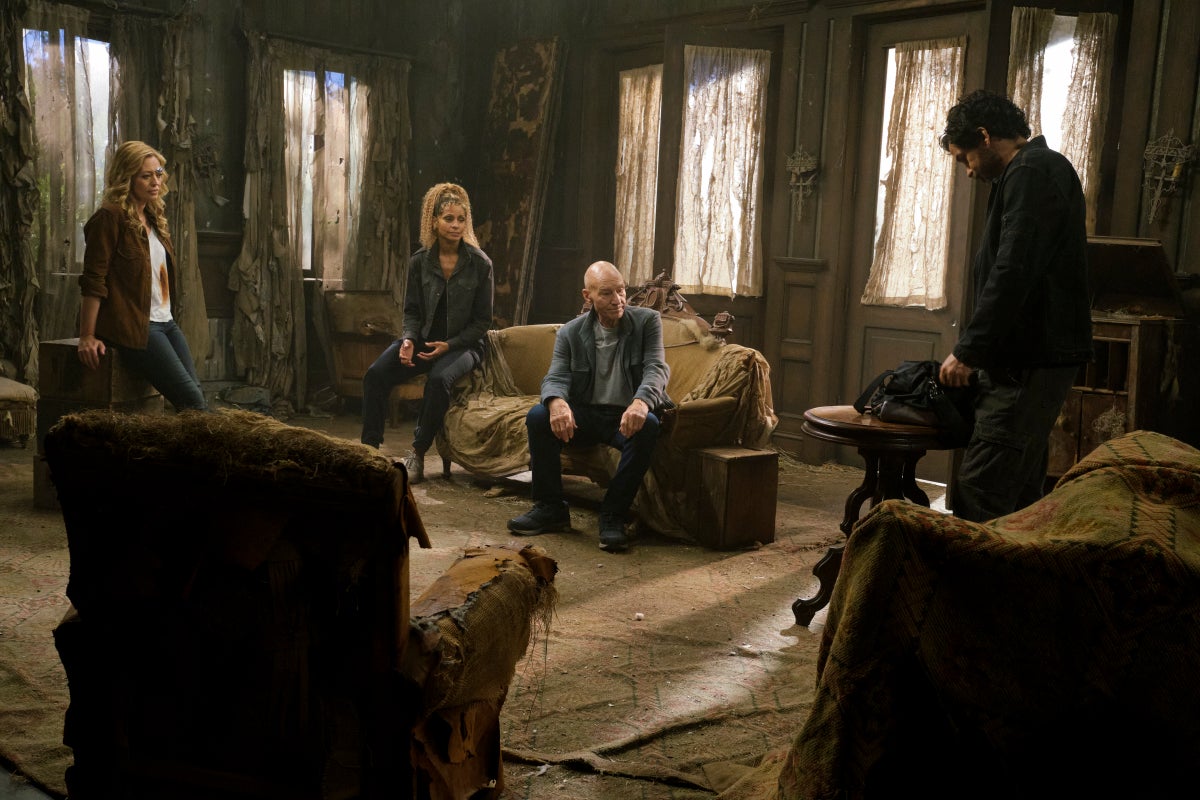
This unhinged feeling begins relatively early on in the episode, when you suddenly realise that “Farewell” is a 50-minute episode of TV that somehow only has about 20 minutes of plot — and all of it is front loaded. With the Borg Queen dealt with last week (well… at this point it’s not a spoiler to say more on that later), Picard, Tallinn, Rios, Seven, and Raffi quickly hatch a game plan to ensure that Dr. Soong can’t prevent Renee Picard from launching the Europa space mission and securing the future they’ve spent much of this season breaking every rule of time travel to safeguard. While the latter trio are left to go investigate just what Soong is going to do exactly — because for a disgraced scientist he has an absurd amount of pull over the Europa mission and, uh, apparently armed weapon systems out of nowhere? — Tallinn and Picard make a dash for the Europa launch site, finally deciding that Renee needs to meet her guardian angel if she has a chance of getting on the mission alive.
And… really, that’s it. Tallinn reveals herself to Renee in an emotional scene, Soong runs around the base being hilariously assholish for no real reason other than that we know he has to be an evil arsehole, Picard meanders about too, and then in the background Rios, Raffi, and Seven try to disable a quartet of killer drones Soong has launched to assassinate Renee. How does he have drones? It doesn’t matter, because as soon as we learn of their existence they’re dealt with, and they’re not even Soong’s only assassination plan — he also has snuck in a toxin graft attached to one of his hands, which he uses to seemingly poison Renee when he bumps into her in a corridor. But surprise! It’s Tallinn in disguise! And she dies in Picard’s arms and we’re all very sad, but happy too, because the real Renee got onboard the ship while Tallinn was busy getting poisoned, and the day is saved.
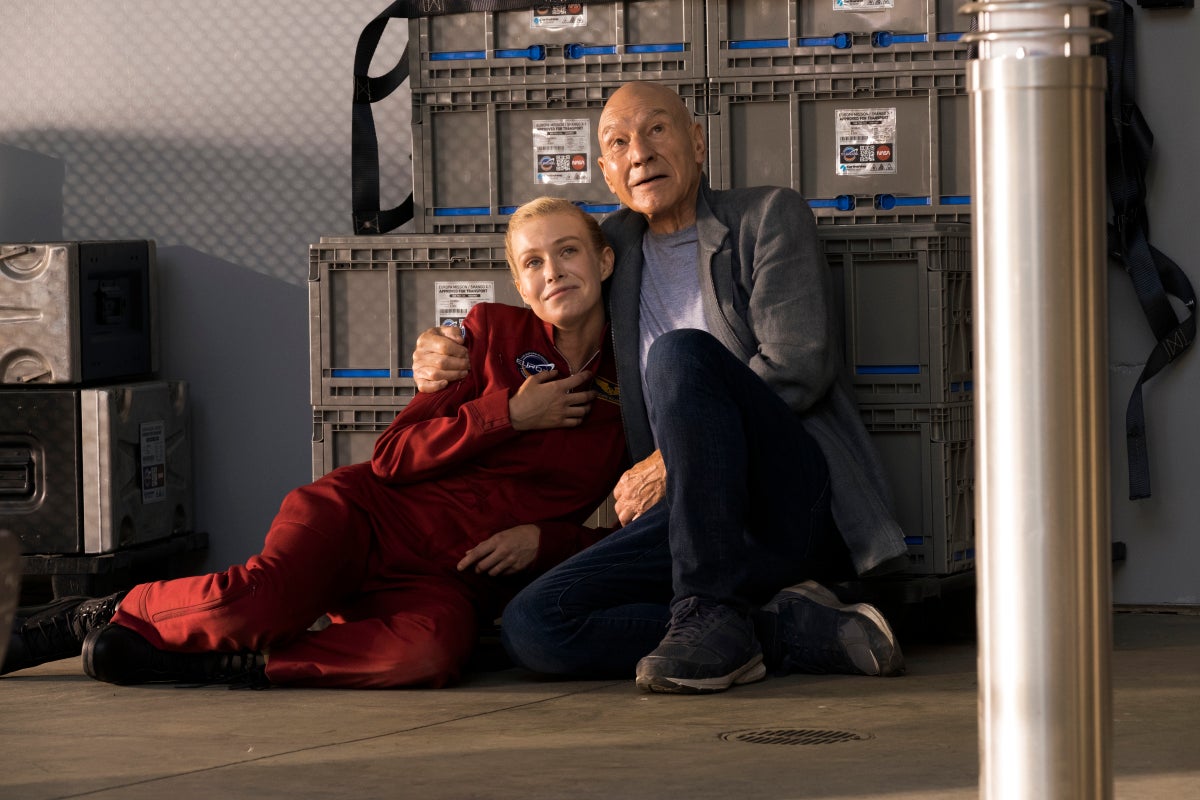
Once again: I cannot stress enough that all of this is delivered in the first 20 minutes of the episode. And that’s it. The big threat of the season that has taken about seven episodes of build-up has a climax hyper-condensed down to this opening act, and it makes everything about it feel so weird. There’s some good stuff in there — the emotional farewell between Tallinn and Picard where both of them each realises that they’ve found peace in sharing themselves with the people they care about is wonderfully done. But it feels like such an absurd way to end a series that has struggled with issues of pace by wrapping up this major arc with a breathless, almost uncaring level of haste.
But it’s not that that makes “Farewell” such a bizarre, rollercoaster of an episode. If this is all it was, it would be perfectly fine — a little demure, but solid. Instead, “Farewell” spends its remaining runtime with an… it’d be too diplomatic to call it an epilogue considering it’s the bulk of the episode, but that’s really what it is. A collection of scenes that just about barely flows from one to the text, as if the script was developed by throwing a dart at a board labelled “A Big List of Things We Should Probably Deal With/Set Up This Season.” And it starts big, because no sooner than we’re done with the Europa plot… Wesley Crusher shows up.
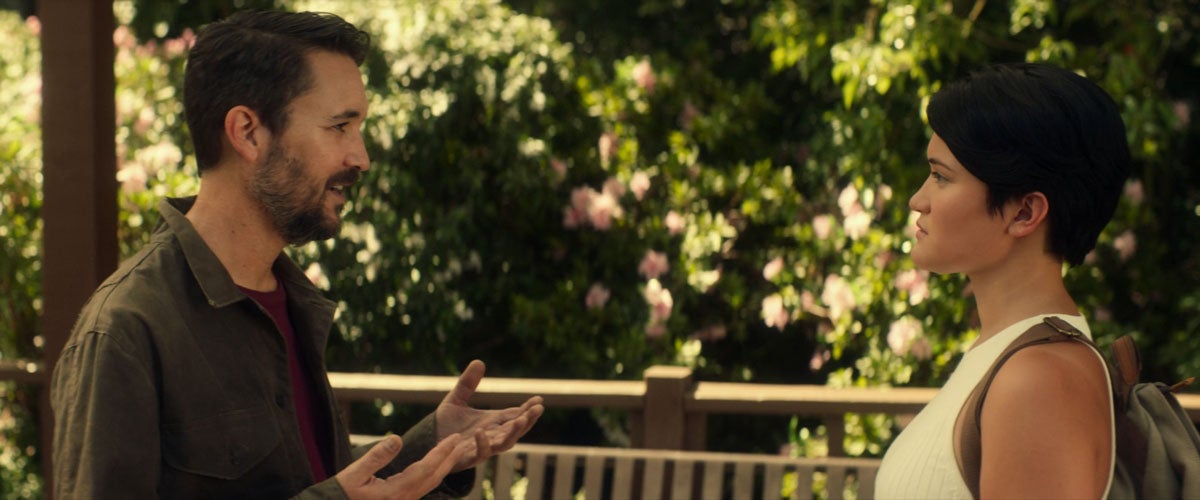
Yes. He wasn’t in that big Picard season three TNG reunion news a few weeks back, but Wil Wheaton is here, out of nowhere, to barge right into one of Picard season two‘s most underdeveloped plot threads: Korre, Soong’s daughter. She’s largely been out of the spotlight since the reveal that Soong artificially constructed her as the latest in a long line of genetic experiments, but her role is made all the more incomprehensible by the fact that, just as she’s done enacting vengeance against her dad by remotely deleting all his research, Wesley arranges a meeting with her. And… recruits her to join the Travellers, the mystery transdimensional beings Wesley left the Enterprise-D to join all the way back in “Journey’s End” nearly 30 years ago? Don’t worry about the fact we saw him back in Starfleet for Nemesis, because Picard certainly doesn’t care, and doesn’t spend the time to explain: Wesley Crusher is here, he scoops up Korre (hopefully meaning Isa Briones will actually get something to do next season, as her time in this one was a major injustice compared to her role in season one), and that’s it. Boop, onto the next plot point to deal with out of nowhere!
This is at least an actually good moment however, instead of an out of nowhere “what the what??” like Wesley. Back at Chateau Picard, the Admiral and his friends are all preparing for what their lives will now look like in 2024, considering the Borg Queen took their ship last episode. They’re content they’ve secured their future, but there’s also a strange melancholy — Raffi and Seven have each other, and Rios now has Teresa and her son, but Picard, after learning to be so open with the people he loves from Tallinn, is all alone… until Q shows up, that is. And what we get is not one last trade of barbs, but arguably one of the strongest scenes not just in this season, but in the entirety of the show.
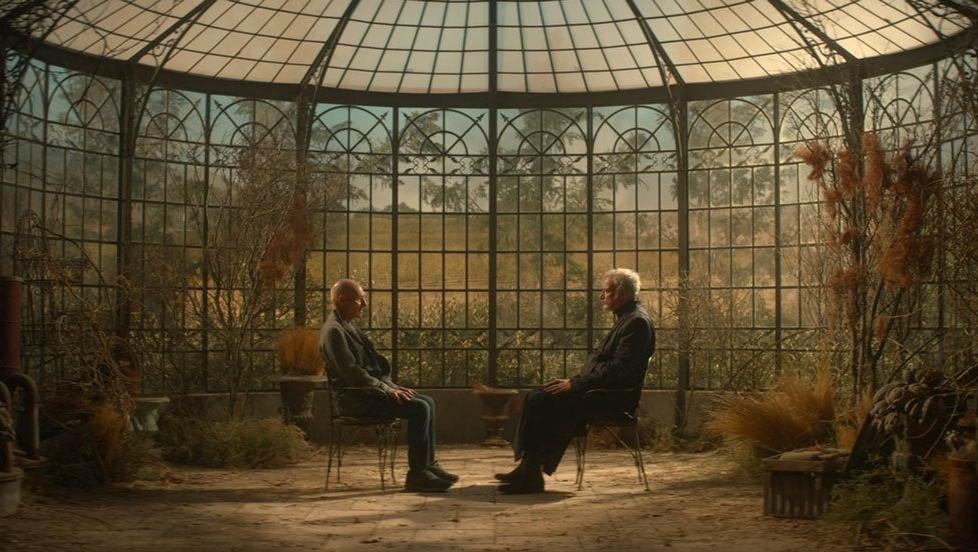
It’s a wonderfully tender and loving performance from John de Lancie, who conducts what are to be Q’s final moments with Picard with an elegant grace — revealing to the man the reason for all these games was not to test, but to teach Picard to love himself as much as those around him, Q included, love him. He doesn’t say love, of course, but the scene absolutely plays out as something incredibly intimate and romantic between the two men. That in confronting his family’s past and his trauma with his mother, Q believes, he can now face death knowing that Picard, one of his favourite people in the entire cosmos, has a chance at a happy future. Q decides he’ll us what little remains of his energy to die in an act that will transport Picard, Raffi, and Seven back to the 24th Century in the process — after Rios decides to stay back in 2024 to be with the person Picard’s mentorship allowed him to find, and love — and it’s a genuinely touching finale for a character that’s persisted mostly as a bit of comedic relief over decades and decades of Star Trek appearances.
And yet, once again, Picard isn’t over just yet — and it’s arguably saved some of its most batshit moments for last. Seven, Raffi, and Picard all find themselves transported by Q’s sacrifice back on the Stargazer where they left it at the end of the season premiere: about to seemingly die at the hands of the Borg Queen. But then, at a breakneck pace, the scene just explodes: it’s not the Queen, it’s Borg Jurati! She’s here not to be evil, but to warn the Federation of an impending giant space hole that’s gonna kill billions of people with a blast! But also the space hole can be fixed by the actually not really-that-big Starfleet taskforce linking their shields up to stop the blast! Seven of Nine gets a Starfleet field commission to become a Captain! Oh, and Elnor’s back too! But they gotta stop the blast! And they do! The Federation is saved! And this is… five minutes of screen time, maybe? On the one hand, yes it does conveniently tie the entire season back together thanks to a causal loop, and it’s a fun way to have the decision for Jurati and the Borg to merge to turn over a new leaf last episode have an immediate ramification, for the better. But it all happens so fast that you just can’t take it in properly, especially right after the tender, emotional farewell between Picard and Q just before this.
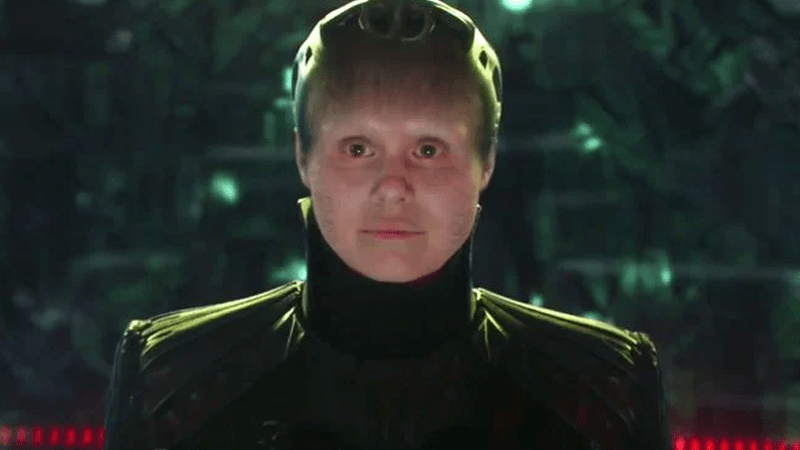
You don’t even have time to relish in that, either, because the episode ends on an even wilder reveal: the space hole and its associated fallout was actually the creation of a new Transwarp Conduit — the method of FTL travel through interconnected subspace tunnels the Borg heavily used in Voyager — but, the Borg don’t know who made it. So, Queen-Jurati offers a proposal: the Borg Collective wants an alliance and temporary membership into the Federation while they deal with whoever and whatever made the conduit, together. It’s wild. Last week I said I was unsure just how Star Trek could possibly deliver on the bold idea of essentially negating one of its most iconic villains in the entire franchise’s history — it’s like the transition the Klingons made between TOS and TNG, but on a factor of 10 considering how much longer the Borg were the ultimate evil of the franchise — and yet, here we are, it’s seemingly doing it an episode later. Obviously, there’s caveats: Queen-Jurati makes it clear this is not an entirely permanent status quo, but at the same time, her demeanour as the new leader of the Borg Collective is unlike anything we’ve seen from the Borg in the past. There is, seemingly, genuine evolution here — and that’s an incredibly exciting set-up going into Picard’s third and final season. When you actually get a few minutes to breathe and think about it as the episode concludes, it’s a quite lovely way to tie together this season’s themes about connection and openness with other people.
But that’s really “Farewell” writ large. When you get a chance to hone in on individual moments and ideas, they work, and in some cases, are even actually really quite good and full of potential. But the episode itself does not give you the chance to hone in on those moments, because as a whole it is absolutely and utterly bizarre. The pacing and tonal disconnect as it flitters from one unconnected moment to the next is such a rollercoaster that it, taken as that whole, can’t be anything other than a complete mess. It’s just like someone proverbially dumping what was left to deal with this season on the floor and then yelling “HEY REMEMBER WHEN WE SAID THE TNG CREW WAS BACK NEXT SEASON YEAH SEE YOU THEN BYEEEE!” as they ran out the door.
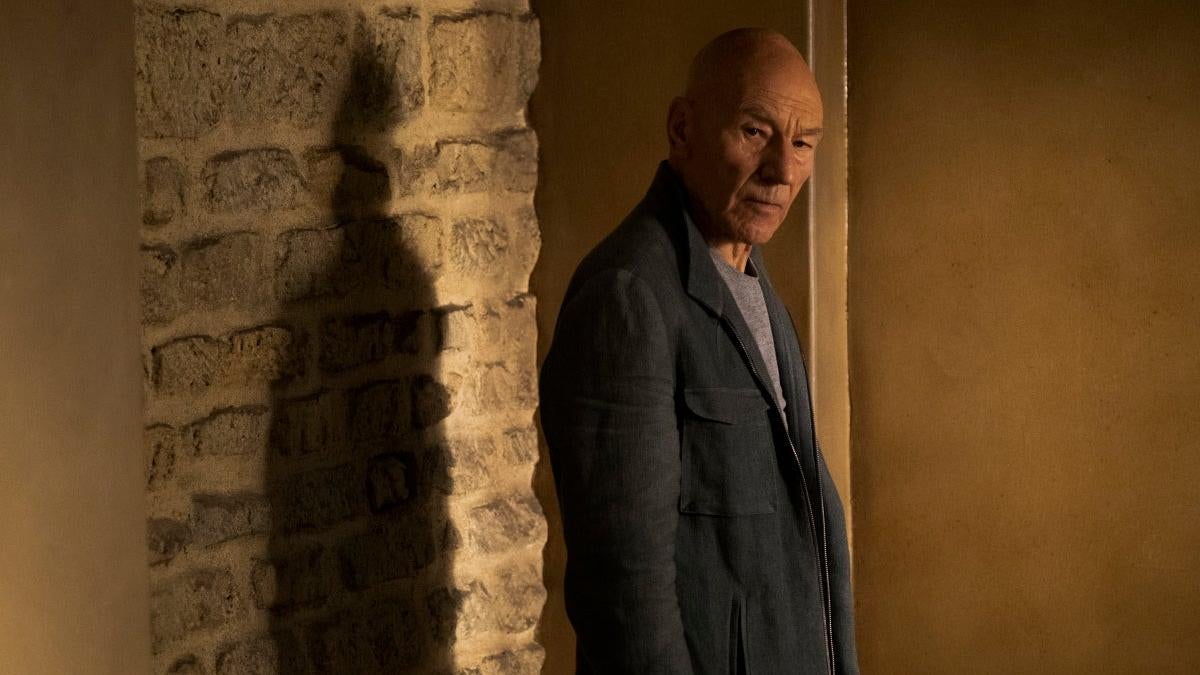
Was that stuff dealt with? Yeah. But it’s just dealt with so weirdly that the good ideas and the promise of it gets lost in the muddiness of just what a wild episode of TV this was. We’ll have to see how it all plays out, now that we know that Picard’s third and final season has some truly big ideas and ramifications to play with — and that’s even before all of Jean-Luc’s friends come back for one last huzzah. Hopefully though, next season being the last means that we can ask for one thing: maybe pace things a little better so we don’t have to have such a bananas finale again?
Want more Gizmodo news? Check out when to expect the latest Marvel and Star Wars releases, what’s next for the DC Universe on film and TV, and everything you need to know about House of the Dragon and Lord of the Rings: The Rings of Power.
